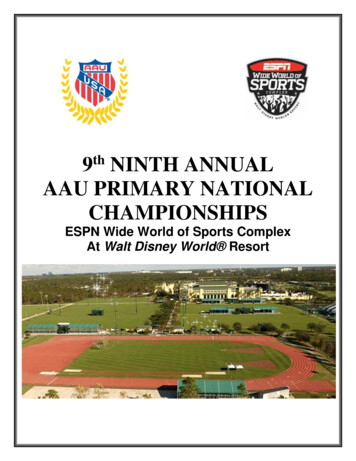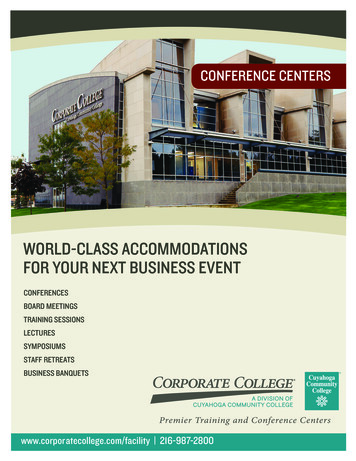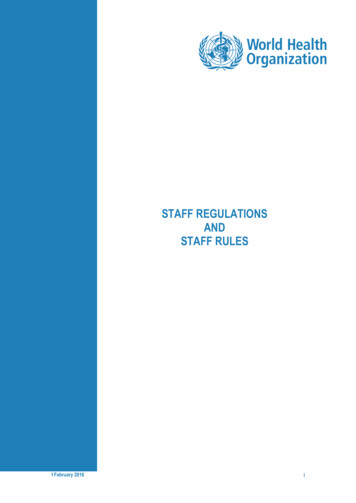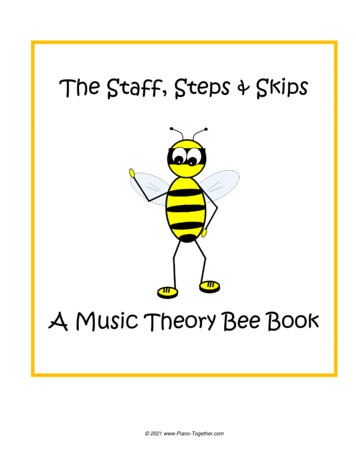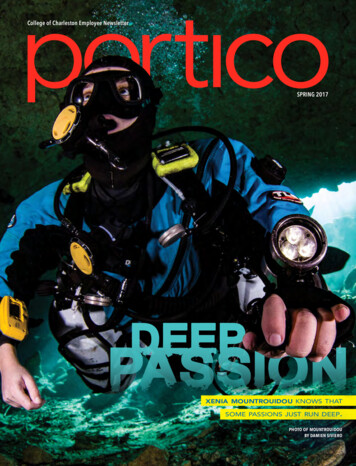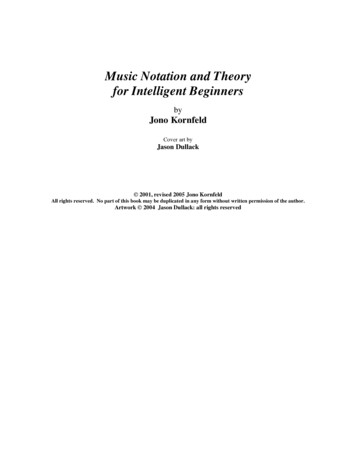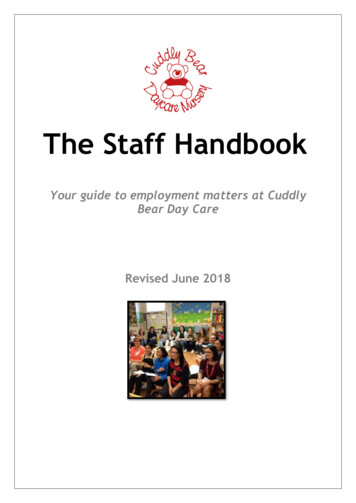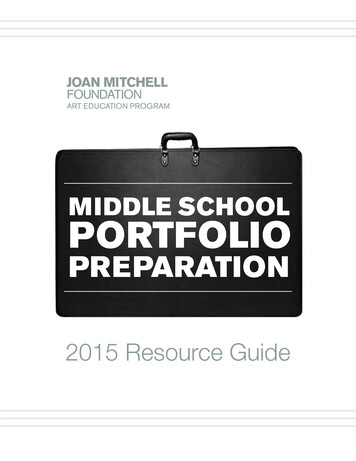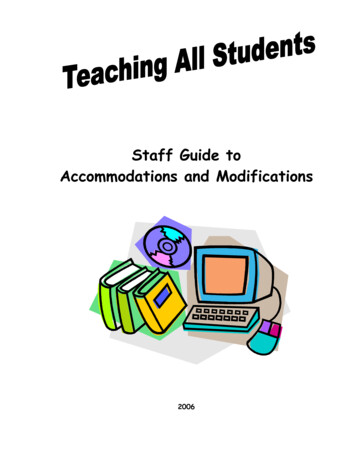
Transcription
Staff Guide toAccommodations and Modifications2006
Teaching All StudentsStaff Guide to Accommodations and ModificationsAccommodations and Modifications, definition of. 1Hierarchy of Accommodations and Modifications . 2Strategy Levels for Adapting Classroom Assignments. 6Fine Motor/Penmanship Accommodations and Modifications .17Reading Modifications/Accommodations .19Writing Modifications/Accommodations.21Spelling Modifications/Accommodations.23Mathematics Modifications/Accommodations . 25.Content Area Modifications/Accommodations .27Behavior Issues and Modifications/Accommodations .31.Elementary Scheduling Problems.33Grading with Accommodations and Modifications.34Recipe for Success (General and Special Education Collaboration).35What Are Disabilities?.36References .401
Accommodations and ModificationsAccommodations and modifications are types of adaptations that are madeto the environment, curriculum, instruction, or assessment practices inorder for students with disabilities to be successful learners and toactively participate with other students in the general education classroomand in school-wide activities.Accommodations are changes in how a student accesses information anddemonstrates learning. Accommodations do not substantially change theinstructional level, content, or performance criteria. The changes aremade in order to provide a student with equal access to learning and anequal opportunity to show what he or she knows and can do.Accommodations can include changes in the following: presentation of a lesson instructional strategies student response format and procedures time/scheduling environment equipment assignment structure-paper/pencil workModifications are changes in what a student is expected to learn. Thechanges are made to provide a student with opportunities to participatemeaningfully and productively along with other students in classroom andschool learning experiences. Modifications include changes in the following: instructional level content/curriculum performance criteria assignment structure-paper/pencil workReprinted with permission from the PEAK Parent Centerwww.peakparent.org2
Hierarchy of Accommodations and ModificationsLayers based on their effect on the general curriculumLayer 0All students do the same assignments.Layer 1All students do basically the sameassignments, except some receive additionalsupport or reinforcement.No ChangesMinimal ClassroomChangesLayer 2Classroom ChangesLayer 3Some Changes toCurriculumLayer 4Significant Changesto CurriculumLayer 5Significant Changesto Curriculum(minimal accommodations)All students learn the same basic content,except with changes in how it is learned ortested. (complex accommodations)Some students do reduced or similarassignments, but at a less frustrating level.(accommodations and modifications)Students do a smaller part of the generalcurriculum.(significant accommodations andmodifications)Students do alternate activities relating tothe general curriculum.(significant accommodations andmodifications)No changes in gradingcriteria. It is thesame for everyone.No changes in gradingcriteria. It is thesame for everyone.Grading criteria mayvary slightly.Grading criteria maybe based on individualgoals and classparticipation.Grading criteria isbased on individualgoals and classparticipation.Grading criteria isbased on individualgoals and classparticipation.*Less than 10% of the special education students participating in general education classesneed Layer 4 or 5 supports. The majority of our special education students can besuccessful and master much of the general education curriculum with Layer 2 or 3accommodations.3
Layers 1 and 2: Minimal AccommodationsEnvironment – Adapt the classroom environment so it makes learningpossible for ALL students. Things you can try: Provide an orderly and predictable room Post VISUAL reminders of the rules and procedures Reduce clutter Be consistent Label key areas clearly – (Turn in papers here.) Seat target students away from major distractions like doorways,pencil sharpeners, other irritating students, etc. Use behavior cue cards and put them on target student’s desk Allow for age appropriate and discrete sensory stimulation – stressballs, fidget toys, etc. These help minimize larger distractions liketipping back in seats, constantly getting out of seat, etc. Allow the use of earplugs or headphones (without input/hookups) toblock out background noise during study time, test-taking, andclassroom assignment time Always keep the Closed Captioning option ON when showing videos orTV segments so that all students can listen to and read theinformation.Content Instruction – Accommodations in instruction and changes ininstructional strategies can enhance learning for the entire class. Thingsyou can try: Give at-risk students a very basic introduction to the subjectimmediately before starting the lesson for the whole class. Askquestions and direct discussions to elicit prior knowledge from theat-risk students. Include hands-on experiences and manipulatives whenever possible. Use experiments and other “being there” experiences to make thelesson memorable. Schedule field trips at the BEGINNING of the unit to givedisadvantaged learners critical background experiences andinformation to benefit from the ensuing instruction.4
Continue to repeat and rephrase the major point(s) of the unit orlesson. Insert meanings of vocabulary continuously throughout the lesson.For example, in a geography lesson the teacher asks the question“What do the contour (or curved) lines on the map represent?” In ascience lesson the teacher explains that mold often grows in placesthat are dark and moist (or wet). During class participation, ask the target student a question aboutthe main idea and state they have a minute to think about it ordiscuss it quietly with their (pre-selected) neighbor. Return to thestudent in a minute and re-ask the question. Allow for additionalresponse time. Provide entertaining stories or fun mnemonics which support a pointor help students remember vocabulary words or concepts. Partner students for activities. Allow for some groups of three sosignificantly challenged students can be easily included with twocapable peers. Demonstrate how to use graphic organizers and then provide them sostudents learn how to categorize and organize information. Provide study guides for tests well in advance of the test. Offer copies of lecture notes to students who cannot copy accuratelyor quickly, have poor penmanship, or note-taking skills. Throughoutthe year help students fix their own notes using yours as a guide.5
Layers 3, 4 and 5 -Increased Accommodationsand ModificationsAssignment Structure-Paper/Pencil Work - Making workbooks, worksheetsor other written assignments accessible to all students can be a challenge.It takes knowing both the students AND the material to be taught in orderto make reasonable adjustments to written assignments. Simple ways tomake accommodations and modifications to paper/pencil tasks can beaccomplished by: highlighting with colored highlighters highlighting with removable highlighter tape marking text with Post-it notes marking pages with Post-it flags color coding pages, notes, and handouts using white out on parts of paper or to eliminate some multiple-choiceanswersContent Instruction Reduce the variety of tasks (The class is practicing mixed additionand subtraction facts with flashcards; two students have additiononly cards.) Eliminate less critical information and facts from a copy of yournotes (or those of a capable peer) using white out tape. Give it tostruggling students to use as a study guide. Physically move closer to a struggling student before asking him/hera question. Teach this system to the student so he/she can mentallyand emotionally prepare for answering questions. This reduces thestress, anxiety, and fear of being selected without warning. Find ways to involve students with significant disabilities in classjobs - passing out papers, collecting materials, taking roll, retrievingitems from the office, etc. When asking questions that have several correct answers, select adisabled student first. He/she might only know one of the answers,whereas other students will know most or all of them.6
Strategy Levels for Adapting ClassroomAssignments (paper/pencil work)The START program at Grand Valley State University compiled a system ofacademic accommodation and modification strategy levels. They range fromnot modified (number 1) to most modified (number 5).1. Open-ended question strategies (Usually not modified)2. Visual organization strategies3. Closed procedure strategies4. Choice strategies5. Yes/No strategies (Too modified for most students)Knowing the answer and being able to articulate it clearly are two different things!Accommodations and modifications help students demonstrate what they DO know.7
1. Open-ended Question Strategies – The open-ended questions arethe most difficult. Many students have trouble with written languageor have difficulty processing spoken language. They may not be ableto answer open-ended questions in the curriculum even though theyhave some understanding of the content.Examples of open-ended question strategies: Science – Describe at least 2 ways Mary can improve her experiment. Social Studies – How are a globe and a dollhouse alike? Math –There are 5 blue birds in a cage. There are 5 times as many greenbirds in another cage. How many green birds are there? Language Arts – In a story, a character usually faces a problem. Forexample, a child named Connor wants a pet but is allergic to cat and doghair. The ending of the story is important. Finish the story in a fewsentences.Open-ended Questions-No Modifications8
2. Visual Organization Strategies – Visual organization strategies makeup the second level of accommodations and modifications. Thesestrategies should provide students with a kick-start and provide anunderstanding of what the key information in the question is or whattype of answer is expected. They assist the student in organizing theanswer.Examples of visual organization strategies: Science – Mary could improve her experiment by:1.2.3. Social Studies – How are a globe and a dollhouse alike? A globe anddollhouse are alike because they both . Math –There are 5 blue birds in a cage. There are 5 times as manygreen birds in another cage. How many green birds are there? Language Arts – Connor wants a pet but is allergic to cat and dog hair.1. Connor should2. This way he3. In the endVisual Organization Example9
3. Closed Strategies – Closed strategies are the third level and makequestion-answering easier. Closed strategies narrow the depth of thecurriculum and help the student understand its focus. They allowstudents to practice answering questions in a systematic format.Closed strategies can alleviate the anxiety the student feels from theoverwhelming complexities of the curriculum.Examples of closed strategies: Science – Mary needs to be sure all the pieces of cloth are Social Studies – A globe and dollhouse are alike because they are aof the real thing. Math –There are 5 blue birds in a cage. There are 5 times as manygreen birds in another cage. How many green birds are there?5 blue birds X 5 green birdsLanguage Arts – Connor is allergic to and hair.A pet he might not be allergic to is a .Closed Strategy Example15. Describe “climate”.10
4. Choice Strategies – Choice strategies provide the student with avisual method aiding recall. They can be made in varying levels ofdifficulty. Choice strategies can also be used with concrete objects.Teachers who already have multiple-choice tests/work developed forthe class can narrow the number of choices to two or three forstudents with significant learning challenges.Examples of choice strategies: Science – Circle one way Mary could improve her experiment.Pieces of cloth need to be the same sizeUse more clothing made by Girbau Social Studies – Circle 2 things that are alike because they are both modelsof the real thing.GlobeStateDollhouse Math – 5 X 5 2025 30 Language Arts – What might be two good pets for Connor?BirdPuppyFishChoice Strategy Example11
5. Yes/No Strategies – Yes/No strategies are not appropriate for mostspecial needs students. They should only be used in extremesituations when it has been determined that all other strategies aretoo difficult for the student. A Yes/No strategy must besystematically taught to a student. The person modifying thecurriculum must consistently deliver the Yes/No strategy to thestudent. Once the student has made a Yes/No decision, the studentmust be held accountable for his actions in order to teach themeaning of Yes/No.Examples of Yes/No strategies: Science – If Mary wanted to improve her experiment, she could make surethe pieces of cloth were the same size.YesNo Social Studies – Are a globe and a dollhouse both models of the real thing?YesNo Math – 5 X 5 20Yes NoLanguage Arts – Is a bird possibly a good pet for Connor?YesNo12
Worksheet/Textbook SampleAccommodations and ModificationsSample from 6th Grade Social Studies TextbookMost special education students will have trouble with the followingassignment because of: difficulty copying information difficulty locating information/answers in textbook the amount of print – students instantly assume it is too hard to do low reading abilities - they feel defeated before they even try it an expectation of failure - they don’t know how to achieve successTextbook Example – Without ModificationsWays to change this assignment Reduce the amount of required writingGive page numbers where answers are foundMake it meaningful by highlighting what is on the testUse visual organization strategies to make assignment less overwhelming13
Visual Organization StrategyUsing Vocabulary sectionAccommodation onlyExactly the same information ispresented, but the content isvisually organized in a table and theamount of writing required by thestudent is greatly reduced.Visual Organization StrategyRemembering What You Read sectionMinimal ModificationThe content is the same. Eachquestion is visually separatedfrom the others with answerlines. Page numbers areprovided to aid the student infinding the needed information.14
Choice StrategyUnit vocabulary, 5th grade exampleIn order to copy the words from the worksheet, the student used a large sticky note tohelp keep her place.The following layer 4 accommodations and modifications were assigned to asignificantly disabled student:1. Find highlighted vocabulary words in the textbook with some help.2. Circle the correct vocabulary words on the worksheet. (Someonechecks paper for accuracy.)3. Copy the words and definitions on separate lined paper.4. Keep copies of all work in a notebook.5. Use copies for study guides.15
6th grade social studies assignment-no modificationsMany students would have difficulty with the following assignmentbecause:1. They are inaccurate when estimating.2. The map scale is too small. Students will get kilometers and milesconfused.3. Students have trouble drawing straight lines.16
Ways to change this assignmentVisual Organization accommodations made to this assignment: lines are drawn on the map measuring card with a straight edge is given to students to useA flat edge measuring card was made using an index card and the map scale.17
Fine Motor/PenmanshipModifications/AccommodationsDelays in fine motor skills can make writing excruciating for disabledstudents. They frequently get frustrated and behavior issues ensue.Alleviating the frustration can result in a positive learning experience.Low technology strategies to try: Use a triangle pencil grip for better controlUse a weighted pencilVary length and thickness of pencilVary writing implement (crayons, colored pencils, fine markers)Put something textured (such as fine sand paper) under the paperProvide various sizes of wide-ruled paper, gradually decrease sizePurchase raised-line paperApply thin lines of glue over lines to make a raised edge when dryUse a straight edge for writingSkip every other line on paperEnlarge paper on copy machine to make fill-in blanks largerUse mounted scissors and paper holder for cuttingHighlight or outline areas to be filled inProvide small mailing labels already typed with the student’s nameReduce the amount of writing/pencil work requiredAllow additional time for writingProvide close-up model to copy from instead of board or overhead screenIndicate to parent when it is appropriate to write for the studentPlace alphabet strip on desk if student has difficulty forming lettersadditional timeweighted pencil18pre-printed name labels
Medium technology strategies to try: Chair with sides for trunk supportSlant board (writing on an easel stand)Label maker for taking spelling testsRecorder for giving oral answers that are later transcribed to paperPartner to take dictation (someone else writes as student talks)clipboard with standdigital recorderHigh technology strategies to try: Word processorDigital notepadComputer with voice recognition capabilitiesNEO AlphaSmart Portable Word Processor19
Reading Modifications/AccommodationsThe majority of students who receive special education services havedifficulty in the area of reading. Since reading encompasses much of theschool day, textbook modifications are critical if these students are toreceive an appropriate education. Many teachers ask the question, “Howcan a student be included in a general education class, if the student isunable to read the textbook? “ Replace that question with, “How muchmaterial will the student be able to learn and/or understand when theinformation is presented in another manner?”Inclusion, 450 Strategies for Success, by Peggy HammekenLow technology strategies to try: Don’t assume the student can read cursive – MANY special needs students(regardless of age) CANNOT read cursive writingRead the text aloud to the class or to a small groupVary the groups so students with disabilities become familiar with theprocedures of working in small groups and are exposed to many peersIf a non-reader is included in the class, group him/her with your best oralreader(s)Divide the class into two groups if another adult is present to helpTeacher, paraprofessional or adult volunteer reads to studentPartner students so they can read aloud to each otherProvide a note-taking format BEFORE beginning reading to guide comprehensionHighlight key words and conceptsHelp student re-read key ideas and highlighted contentSimplify complex text by rewording (break a complex sentence into several shortsentences)Reduce the amount of reading required (Student reads the summary three timeswhile the class reads the entire chapter.)Allow additional time to readProvide vocabulary lists with user-friendly definitionscolored strip - simple visualto help students keep theirplace as they read20
Substitute one-page summaries or study guides that identify key terms and ideasinstead of the whole reading assignmentUse Closed Captioning for all TV/video viewing so students see words and speechconnected.Put main ideas on note cards and help students organize themGlue dots on page corners to make turning pages easier for very young studentsProvide colored/highlighted strips to assist students in following along intextbookUse bookmarks to help keep placeProvide books on tape, videotapes, etc (free from book companies, libraries, andservices to the visually impaired)Use large print text (enlarge on copier or books on loan from Visually Impairedprograms)Add images that illustrate the content (i.e. Google Images)Dictionary definition: in teg ri ty (ĭn-tĕg'-rĭ-tē)n.1. Steadfast adherence to a strict moral or ethical code.2. The state of being unimpaired; soundness.3. The quality or condition of being whole or undivided;completeness.Student Friendly definition: in-teg-ri-ty (in-teg-ru-tee)n. doing what is rightHigh technology strategies to try: Online booksElectronic booksText reader (Reading Pen, Scan and Read)Electronic dictionaryThe Reading Pen scansand reads aloud wordsand sentences. It alsoprovides definitions.Computer programs canread aloud from websites,books on line, scannedworksheets, and more.21
Writing Modifications/AccommodationsMany students have difficulty with written language for a variety ofreasons. Some students have trouble generating ideas or transferringtheir ideas into written words. Other students do not understandgrammar, syntax, or the mechanics of writing. Still others have difficultyprocessing language.Generating Ideas: Teach writing each day; don’t just assign itGive the student specific instructions-gradually decrease structure asconfidence buildsAllow student to use ideas from a word/idea bankAllow student to write about segments of the same topic for several daysAfter a topic has been chosen, assist the student in developing a visualoutline/graphic organizerKeep pictures available to help generate ideasRequire a minimal amount of writing per day-gradually increase the expectations(Be prepared to start with very little!)Allow student to bring a picture from home to write aboutAllow lists and simple sentences-help student to gradually become more complexAllow students to dictate ideas to teacher, paraprofessional or volunteerRequire/encourage student to copy material from the volunteer’s dictationProvide a list of words for the student to useProvide a clearly written topic sentence and an informal outline to get thestudent started on a paragraph or essay22
The Writing Process: Avoid corrections in the mechanical aspects in early stages of writingconcentrate on idea developmentTeach and require the use of graphic organizers/outlines/mapping skills to helpstudents learn to visualize the parts of the paragraph/essay/storyTeach importance of beginning, middle and end of storiesRequire students to incorporate transition words (ex. first, next, then, last ormost importantly, also of interest ) into paragraph writingTeach proofreading skillsAllow use of checklist for proofreadingHave the students read the story aloud to identify inaccurate construction ofsentencesEncourage students to share stories with the class or a partner - do not requiredisabled students to read their work to the class if they are uncomfortable(They learn from hearing good stories modeled for them.)Allow the use of a computer or word processorValue quality over quantity - look for a well-written paragraph instead of a longerstory of mutilated sentences and atrocious spellingAllow fill-in-the-blank forms for the beginning stages of report writingAllow multiple formats for presentations, including some that don’t includewritingAllow reduced sources and modified format when writing research papersAllow disabled students to work together to generate one reportAllow students to dictate stories, reports, etc. to volunteers/peersRequire students to practice reading aloud the stories they dictatedDevelop a spelling dictionary for frequently misspelled words23
Spelling Modifications/AccommodationsSpelling should be compatible with the student’s reading level. Foryounger students or significantly disabled students who are not readyfor a formal spelling program, students can practice letter formation,sound/symbol relationships and fine motor skills. As soon as the child iscapable of remembering short sight words (is, the, a, etc.) or can blendtwo sounds (an, am, in, on, etc.), a formal spelling program can beimplemented.Pre-spelling activities: Create a spelling list of consonant sounds that coincide with the initial lettersounds of the class spelling listStudent writes the beginning sound of word while the class writes the wordBegin with simple sight words and short phonetic words as soon as the childknows enough letters and soundsPractice spelling student’s own name and gradually add other familiar names tospellDevelop a spelling list that also makes a sentence-“I am Meg.”Allow lots of practice reading, tracing, writing, sequencing, stamping, building andfinding spelling words and sentencesSpelling activities: Give student a PRINTED list of words to practice (not cursive)Reduce the number of spelling words on the listAllow student to set an individual spelling goal for number correct on testGradually increase the number of required spelling words IF the student is makinga mastery goalGroup spelling words into word families or similar patternsReplace a few unfamiliar words with high frequency sight wordsIncorporate familiar words from student’s basal reader or leveled booksChose spelling words relevant to curriculum and consistent with the child’svocabularyTeach students to isolate (say) each sound in the word and match them with thespelling for that sound:sound:Spelling:/th/ththrough/r/r24/oo/ (as in pool)ough
Create a format that can be used with all students even though word lists varyUse the previous year’s spelling listsTeach student to highlight base words, prefixes and suffixes in different colorsTeach only one spelling rule at a timeCombine spelling and handwriting goals to save time - practice spelling wordsduring handwriting practiceAllow spelling practice time each dayProvide fun drill and practice exercises like bingo, hangman, word finds, etc.In addition to paper and pencil practice, encourage use of practice with whiteboards, paint, stamps, computer, orally in small groups, or on a tape recorderProvide audiocassette with words pronounced and spelled for student to listen toduring extra class time or at home if appropriateTeach mnemonic devices to help spell difficult words (Wed - nes- day, theprincipal is your pal)Allow some choice for spelling practice methodsEncourage student to verbalize sounds while writing spelling wordsMarking affixes on spelling words and pairingwith student friendly definitions:A label maker can be used to takea spelling test or to practice wordsprepare - to get readypresume - to expect or assume with confidencefunction - what something doesretention - holding something backuncovered - shown, not covered25
Mathematics Modifications/AccommodationsStudents with disabilities frequently have difficulty with auditory andvisual processing, along with delays in short term memory. Because mathusually requires the use of multiple sequential steps in order to produce ananswer, students get frustrated and confused. Students will need the useof concrete objects (manipulatives) and visual examples whenever possible.Low and medium technology strategies to try: Introduce concepts using real life examples whenever possibleDon’t worry about perfect calculations when teaching a concept-focus on theprocess firstTeach key math terms separatelyProvide student with an easy to read dictionary of required math termsInclude drawings and examples to illustrate the meaning of termsWhen teaching abstract concepts, use drawings, diagrams, and visualdemonstrations to establish a concrete relationshipWhen demonstrating concepts use color coding to focus student attentionHighlight similar math operations to help students focus on the operation (ex.multiplication in blue, division in green)Cluster similar problems into groupsTeach fact families and build fluency with games and challengesTeach students to highlight each operation in mixed-operation worksheetsModel math problems using manipulatives whenever possible (overheadmanipulatives for math are readily available)When teaching number lines-use tape or draw a number line on the floor forstudents to walk on (This assists students with directionality too.)Enlarge worksheets/assignments on copier to give more writing spacePut boxes around each problem to visually separate themUse manipulatives whenever possible (coins, counters, grouping rings)Allow use of number linesAllow use of a multiplication chartUse large graph paper to assist with proper alignment of columns of numbersReduce the number of practice or test problems on a pageAllow additional time to complete assignmentsSimplify and rephrase vocabulary in word problemsHave students verbalize the process to youTurn lined paper vertically so the student has ready made columnsDon’t penalize students with fine motor difficulty by requiring them to copyproblems-focus on the math operations and allow them to use copied sheets26
Create a math reference book that has easy to read information and illustrationsof the concepts covered in classChallenge student to do just one line of problems at a timeUse memory devices (Order of operations: “Please Excuse My Dear Aunt Sally”for Parentheses, Exponents, Multiplication, Division, Addition, Subtraction)CalculatorLarge-size calculatorSimple-function calculatorCalculator with print-outCoin-u-lator (calculator that performs operations with coin buttons)Coin-u-latorHigh technology strategies to try: Talking calculatorAdapted measuring devices (talking ruler, clock, etc.)Computer with math softwareWireless number pad for computerSpeech recognition devicestalking tape measure27
Content Area Modifications/AccommodationsPlease refer to the other sections for basic modification andaccommodation suggestions. Following are additional things you can try i
struggling students to use as a study guide. Physically move closer to a struggling student before asking him/her a question. Teach this system to the student so he/she can mentally and emotionally prepare for answering questions. This reduces the stress, anxiety, and fear of being selected without warning.
